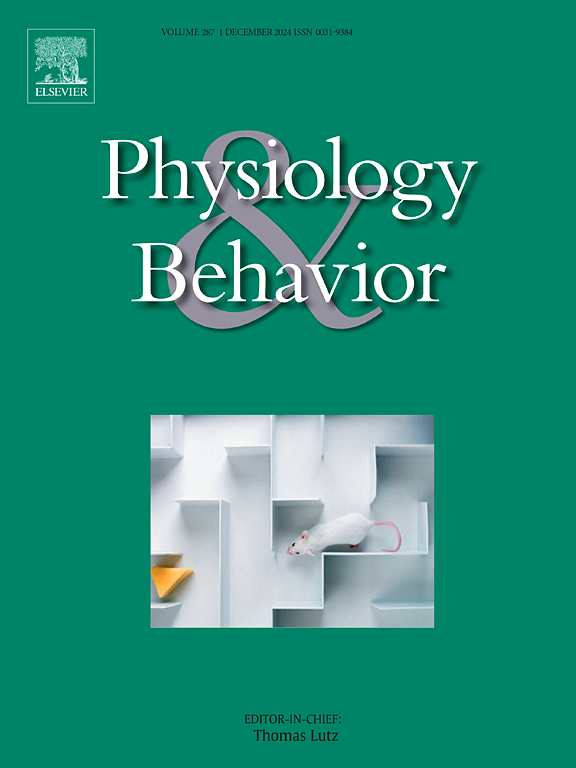超重和肥胖女性在饮食诱导的减肥过程中甜食偏好的特征稳定性:来自利兹食物偏好问卷的证据。
IF 2.5
3区 医学
Q2 BEHAVIORAL SCIENCES
引用次数: 0
摘要
简介:我们知道,甜味偏好会影响食物选择和饮食质量,但这些偏好随着时间的推移(尤其是在有组织的减肥干预期间)的稳定性仍不清楚。本研究使用利兹食物偏好问卷(LFPQ)(一种经过验证的生态学有效工具)探索了超重/肥胖女性饮食诱导减肥期间甜食偏好的个人稳定性。方法:将46名超重或肥胖女性(平均年龄 = 34.9岁,平均BMI = 29.2kg/m2)随机分配到连续或间歇能量限制干预组,目的是在12周内实现体重减轻≥5%。在基线、第2周和干预后评估甜食偏好。使用类内相关系数(ICC),在单一时间点(ICC single)和跨多个时间点(ICC Average)检查了甜食偏好的稳定性。结果:两种饮食干预均显著降低体重(CER = - 4.93kg, IER = -4.42kg)和体脂(CER = -3.67kg, IER = -3.04kg),组间无差异。在干预期间,两组的甜食偏好均未发生显著变化。在单次测量中,甜味偏好表现出中等到良好的稳定性(ICC single: .564-.750),在多个时间点上表现出良好到优异的稳定性(ICC Average: .795-.900),这表明在整个干预过程中,参与者保持了相对于其他人的甜味偏好。结论:超重/肥胖女性在饮食诱导的减肥过程中,甜食偏好保持稳定。尽管表现出一些日常变化,但对甜食的偏好显示出尽管体重和组成发生了重大变化,但这种特征仍然存在。这些发现对体重管理策略具有重要意义,表明干预措施可能需要与个人固有的口味偏好一起工作,而不是改变。本文章由计算机程序翻译,如有差异,请以英文原文为准。
Trait-like stability of sweet food preferences during diet-induced weight loss in women with overweight and obesity: Evidence from the Leeds food preference questionnaire
Introduction
Sweet taste preferences are known to influence food choice and diet quality, but the stability of these preferences over time – particularly during structured weight loss interventions – remains unclear. The present study explored the within person stability of sweet food preferences using the Leeds Food Preference Questionnaire (LFPQ), a validated, ecologically valid tool, during diet-induced weight loss in women with overweight/obesity.
Method
Forty-six women with overweight or obesity (mean age = 34.9 years, mean BMI = 29.2kg/m2) were randomly allocated to continuous or intermittent energy restriction interventions designed to achieve ≥5 % weight loss within 12 weeks. Sweet food preferences were assessed at baseline, week 2 and post-intervention. Stability of sweet food preferences was examined using intraclass correlation coefficients (ICC), at a single timepoint (ICC Single) and across multiple timepoints (ICC Average).
Results
Both diet interventions produced significant reductions in body weight (CER = - 4.93 kg, IER = -4.42 kg) and body fat (CER = -3.67 kg, IER = -3.04 kg) without differences between groups. No significant changes in sweet food preferences occurred during the intervention for either group. Sweet preferences showed moderate to good stability for single measurements (ICC Single: 0.564–0.750) and good to excellent stability across multiple timepoints (ICC Average: 0.795–0.900), indicating participants maintained their relative sweet preference position compared to others throughout the intervention.
Conclusion
Sweet food preferences remain stable during diet-induced weight loss in women with overweight/obesity. While exhibiting some day-to-day variations, sweet preferences demonstrate trait-like characteristics that persist despite significant changes in body weight and composition. These findings have important implications for weight management strategies, suggesting that interventions may need to work with, rather than to change, an individual’s inherent taste preference.
求助全文
通过发布文献求助,成功后即可免费获取论文全文。
去求助
来源期刊

Physiology & Behavior
医学-行为科学
CiteScore
5.70
自引率
3.40%
发文量
274
审稿时长
47 days
期刊介绍:
Physiology & Behavior is aimed at the causal physiological mechanisms of behavior and its modulation by environmental factors. The journal invites original reports in the broad area of behavioral and cognitive neuroscience, in which at least one variable is physiological and the primary emphasis and theoretical context are behavioral. The range of subjects includes behavioral neuroendocrinology, psychoneuroimmunology, learning and memory, ingestion, social behavior, and studies related to the mechanisms of psychopathology. Contemporary reviews and theoretical articles are welcomed and the Editors invite such proposals from interested authors.
 求助内容:
求助内容: 应助结果提醒方式:
应助结果提醒方式:


